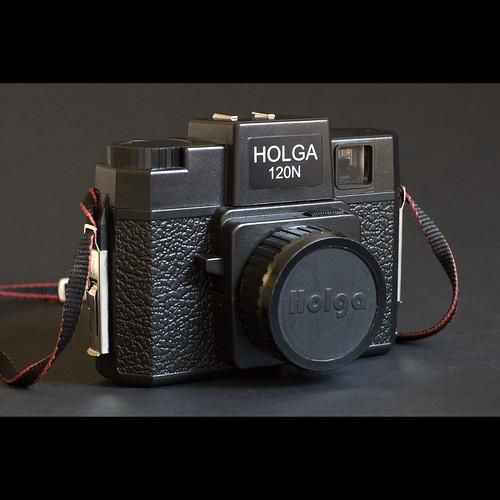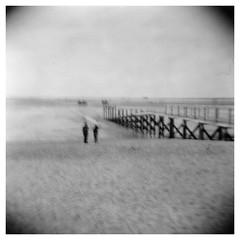 |
| My Holga 120N |
I have had and used my Holga 120n for about 18 months now. I first discovered the Holga via Flickr after I started to play round with film again. The results I saw on Flickr instantly grabbed me and I knew I had to try one of these cameras out.
The Holga is basically the most basic camera type there is barring of course a pinhole. Formed from a simple plastic box front by a cheap plastic lens. The early models featured 2 different aperture settings, although it is widely acknowledged that switching between these didn't actually change the aperture due to the way the camera was manufactured. This mistake has been corrected on the more modern version including the one I have. The Holga also produces a pronounced vignette when shot at the smallest aperture setting. The focus is by the "zone focus" method, and the viewfinder is a simple view-finder type with no parallax helper lines - the viewfinder also shows a much wider view than is captured via the lens. This combination of plastic body (which is prone to gorgeous lightleaks due to the lack of seals), zone focusing and plastic lens lends a dreamlike or vintage feel to the images produced on the film.
Another bit of interest on the Holga is the odd shutter switch, which is located on the side of the lens housing - pretty standard in the olden, golden days; but confuses the modern shooter no end. The shutter itself isnt linked to the wind-on, meaning that double, triple or however-many exposures are available, be that planned or not. Other non-planned effects are gained from the "bulb" setting which can easily be knocked on by mistake, changing the set 1/60 second shutter speed to "however long the shutter switch is held for", resulting in many a blurry, movement filled image.... and of course there is the problem of leaving the lens cap on - you are not a Holga shooter until you have got a roll of film back and realised the 6 black images are "lens cap on" moments.
The Holga takes 120 film, a format refereed to as "Medium Format" due to positioning between 8x10 "large format" and 35mm standard or "small format". The 120 film is paper backed, and on the paper is marked frame number for the different aspect ratios that can be generated on the emulsion. The Holga can be setup to produce 6x6 square images, or 6x4.5 portrait orientation images. I choose to shoot my Holga exclusively at 6x6 as I find the square formatting give me something different to work with. When used like this, you get 12 images on each roll of 120 film, with 6x4.5 yielding 16.
Getting 120 film developed and processed is still, despite what many believe, easy to achieve. There are many online labs that allow postal orders of film, usually offering 2-3 turn around. And of course there is always the option to develop at home if you are that way inclined. I have my 120 developed by either Peak Imaging or Whole Picture Online, both of which also scan to CD at the time of processing as my aged Epson scanner doesnt take the larger negatives this film produces.
Ive shot both colour negative and black & white negative in my Holga. I havent yet tried chrome (slide) film yet, either straight or cross-processed. I have found that Fujifilm Colour Pro400 gives me the right blend of film speed, grain and colour rendering and is my film of choice when shooting "toy" cameras such as my Holga or Lubitel TLR.
For me at least, the Holga produces lovely evocative images and gives me a more freeform shooting methodology compared to shooting digital, instant ot even "normal" film. The ease of use combined with the fact that you dont know exactly what will appear on the final image leads to a more creative shooting experience that it lacking in todays world of megapixels and ultra-zoom lenses. Plus the camera is so cheap you don't mind taking more risks with it, putting it in situations you would dream of putting a DSLR.
I actually have a 2nd Holga 120N which I kind of won in photo competition, and it set-up with a 135 adapter to take spooled 35mm film and exposure the image on the film and sprocket holes. As yet, I havent had a chance to use it...
Some online Holga Resources:
- Holga on Camerapedia: http://camerapedia.wikia.com/wiki/Holga
- Holga on Wikipedia: http://en.wikipedia.org/wiki/Holga
- Holgarama, UK Holga suppliers: http://www.holgarama.com/
- Squarefrog, Holga fan-site: http://www.squarefrog.co.uk/
- Holga Group on Flickr: http://www.flickr.com/groups/86881528@N00/
- FitzhughFella: http://www.flickr.com/photos/duncanholley/
- abdukted1456: http://www.flickr.com/photos/abdukted1456/
- Donnie Vendetta: http://www.flickr.com/photos/donnievendetta
- Skissen: http://www.flickr.com/photos/skiss1/
- Katworks: http://www.flickr.com/photos/bzphoto/
- nefoto...: http://www.flickr.com/photos/nefotografas/



![Like A Stone. [Explored]](http://farm6.static.flickr.com/5136/5566925079_8c70645bdd_m.jpg)

![Wide Open. [explored]](http://farm5.static.flickr.com/4092/4845421407_a2bc84989b_m.jpg)
![And Now I'm Fine, My Mind Is Clear And Nothing Bad Can Touch Me Here. [explored]](http://farm5.static.flickr.com/4103/4843018551_1a40b6bcf5_m.jpg)
![I See Your Hair Is Burnin' Hills Are Filled With Fire. [explored]](http://farm5.static.flickr.com/4095/4773521909_a55a4a71d6_m.jpg)
